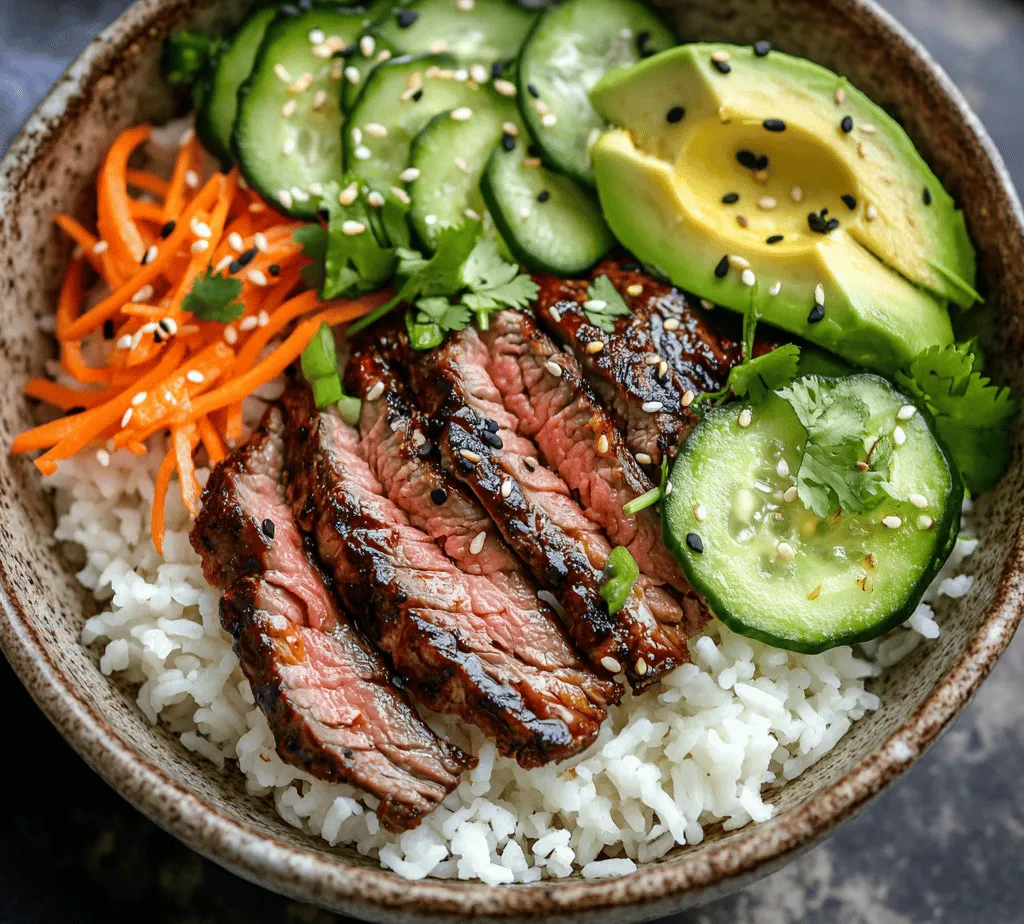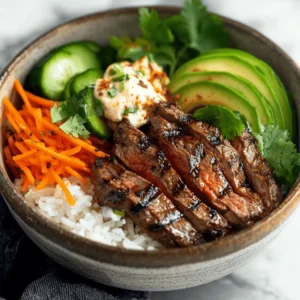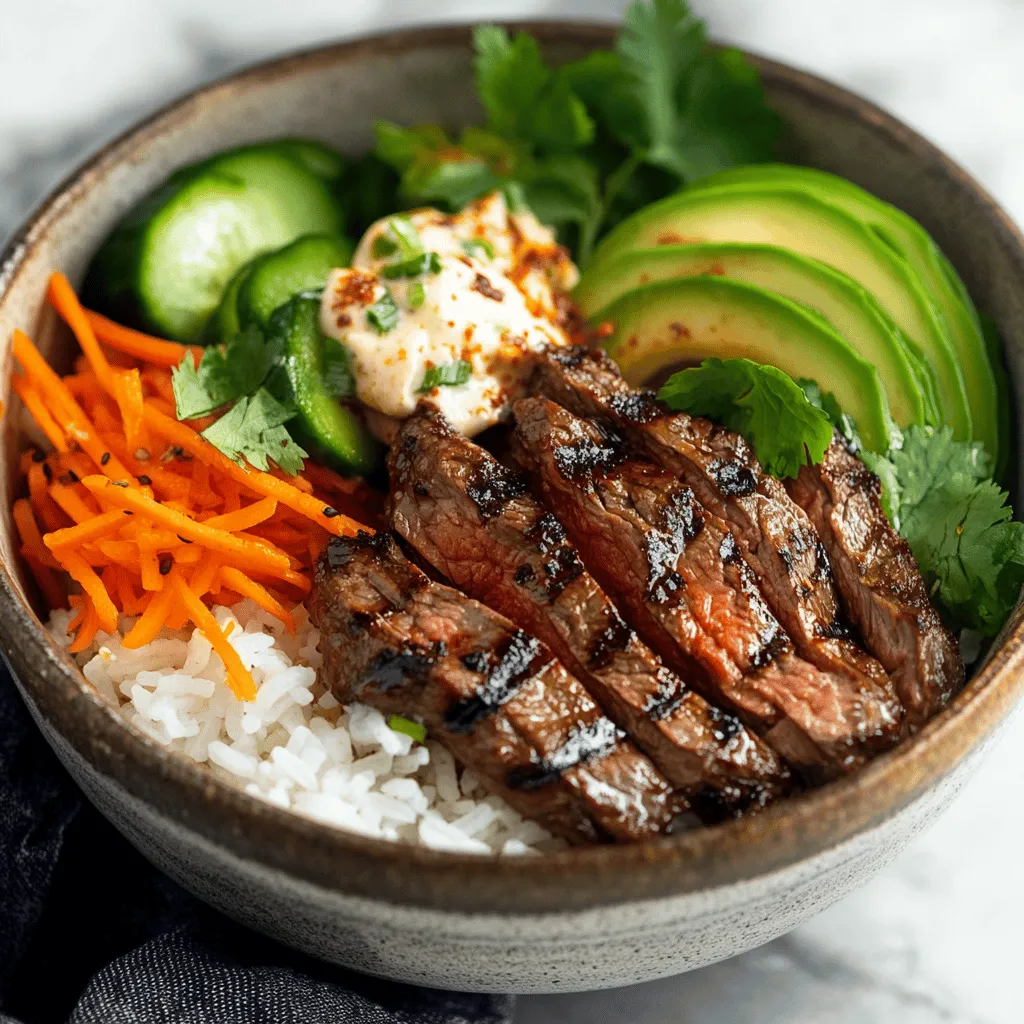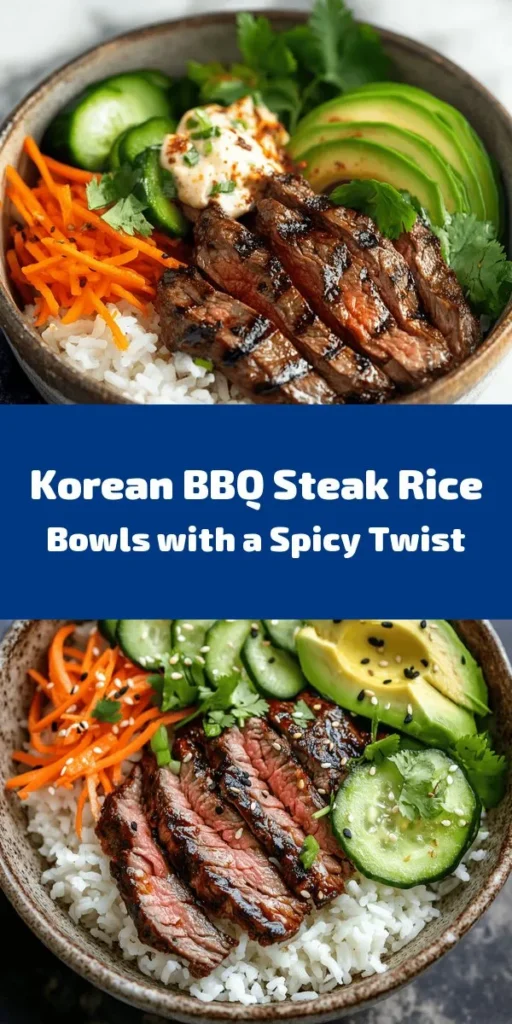Exploring the vibrant flavors of Korean cuisine can be an exhilarating experience, especially when it comes to dishes like Korean BBQ Steak Rice Bowls. This recipe combines tender, marinated flank steak with a rich and spicy cream sauce to create a balanced and satisfying meal. The dish is not only visually appealing but also packed with a delightful mix of textures and tastes. In this article, we will delve into the step-by-step process of preparing these delicious rice bowls, highlighting the ingredients and techniques that make this recipe a must-try for any home cook.
Understanding the Ingredients
To create the perfect Korean BBQ Steak Rice Bowls with Spicy Cream Sauce, it’s essential to understand the core ingredients that bring this dish to life. Each component plays a vital role in delivering the authentic flavors and textures that make Korean cuisine so beloved.
Flank Steak
Flank steak is a lean cut of beef that comes from the abdominal muscles of the cow. It is known for its rich flavor and fibrous texture, making it an excellent choice for marinating and grilling. When cooked properly, flank steak becomes incredibly tender, and its beefy taste pairs beautifully with the bold flavors of the marinade and sauce. For this recipe, it’s recommended to slice the steak against the grain after cooking, which further enhances its tenderness and makes it easier to chew.
Marinade Essentials
The marinade is where the magic begins, infusing the flank steak with deep flavor and ensuring it remains juicy during cooking. The key ingredients in this marinade include:
– Soy Sauce: This staple of Korean cuisine adds umami and saltiness, enhancing the natural flavor of the beef.
– Brown Sugar: Balancing the saltiness of the soy sauce, brown sugar contributes sweetness that caramelizes beautifully when grilled, creating a delicious crust on the steak.
– Sesame Oil: A few drops of sesame oil impart a nutty aroma and flavor, characteristic of many Korean dishes.
– Garlic and Ginger: Fresh garlic and ginger provide aromatic depth, with ginger also aiding in tenderizing the meat.
– Rice Vinegar: This ingredient adds a touch of acidity, brightening the overall flavor profile and helping to tenderize the steak.
– Black Pepper: A sprinkle of freshly cracked black pepper adds a hint of heat without overpowering the dish.
Together, these marinade ingredients work synergistically to create a flavorful and tender steak that serves as the star of the dish.
The Spicy Cream Sauce
The spicy cream sauce is where the dish really shines, offering a creamy, spicy kick that complements the savory steak. The sauce consists of:
– Mayonnaise: The base of the sauce, mayonnaise provides creaminess and helps to carry the flavors of the other ingredients.
– Gochujang: This fermented Korean chili paste adds heat and a hint of sweetness, making it a key ingredient in many Korean sauces and marinades.
– Lime Juice: A squeeze of fresh lime juice brightens the sauce and adds a refreshing acidity that cuts through the richness.
– Honey: A touch of honey enhances the sweetness and balances the heat from the gochujang.
– Garlic Powder: For added depth and flavor without the extra moisture of fresh garlic.
– Cayenne Pepper: This optional ingredient can be adjusted based on personal spice tolerance, providing an extra kick if desired.
When blended together, these ingredients create a sauce that is creamy, spicy, and utterly delicious, making it the perfect accompaniment for the marinated steak.
Fresh Toppings
Finally, adding fresh toppings is crucial for elevating the dish and providing a contrast to the savory and spicy elements. Consider including:
– Cucumbers: Thinly sliced or julienned cucumbers offer a refreshing crunch that balances the richness of the dish.
– Carrots: Shredded or thinly sliced carrots provide a sweet, crunchy texture that complements the other ingredients.
– Avocado: Creamy avocado slices lend richness and a velvety texture that enhances the overall mouthfeel of the rice bowl.
– Cilantro: Fresh cilantro adds a burst of flavor and brightness, tying the dish together with its aromatic qualities.
– Lime Wedges: A squeeze of lime just before serving can elevate the flavors even further, making each bite vibrant and fresh.
Step-by-Step Preparation
Now that we understand the ingredients, let’s dive into the preparation process. The following sections will guide you through each step, ensuring you create Korean BBQ Steak Rice Bowls that are bursting with flavor.
Marinating the Steak
Marinating the flank steak is a crucial step that not only infuses the meat with flavor but also tenderizes it. Here’s how to do it properly:
1. Prepare the Marinade: In a medium-sized mixing bowl, combine the soy sauce, brown sugar, sesame oil, minced garlic, grated ginger, rice vinegar, and black pepper. Whisk together until the sugar is dissolved and all ingredients are well incorporated.
2. Marinate the Steak: Place the flank steak in a shallow dish or a resealable plastic bag. Pour the marinade over the steak, ensuring it is evenly coated. If using a bag, seal it tightly and massage the marinade into the meat.
3. Refrigerate: Allow the steak to marinate in the refrigerator for at least 30 minutes, but ideally, aim for 2-4 hours. For maximum flavor, marinating overnight is recommended. This extended time allows the flavors to deeply penetrate the meat.
4. The Science Behind Marination: During marination, the acidity from the ingredients, particularly rice vinegar and soy sauce, helps break down the protein fibers in the meat, making it more tender. Additionally, the flavors from the marinade infuse into the steak, resulting in a deliciously seasoned dish.
Creating the Spicy Cream Sauce
While the steak is marinating, it’s the perfect time to whip up the spicy cream sauce. The following steps will guide you:
1. Combine Ingredients: In a small mixing bowl, combine mayonnaise, gochujang, lime juice, honey, garlic powder, and cayenne pepper (if using).
2. Mix Well: Using a whisk or a fork, mix the ingredients until smooth and fully combined. Taste the sauce and adjust the seasoning to your preference. If you prefer it spicier, you can add more gochujang or cayenne pepper. For a sweeter sauce, increase the amount of honey.
3. Refrigerate: Once prepared, cover the sauce and refrigerate until you are ready to serve. This resting period allows the flavors to meld together, enhancing the overall taste.
Cooking the Steak
After marinating the steak and preparing the sauce, it’s time to cook the meat to perfection. Here’s how to do it:
1. Preheat the Grill or Skillet: If using a grill, preheat it to high heat. If cooking on the stovetop, heat a cast-iron skillet or a heavy-bottomed pan over medium-high heat. Add a small amount of oil to prevent sticking.
2. Remove Excess Marinade: Take the marinated flank steak out of the refrigerator and remove it from the marinade. Allow any excess marinade to drip off, as too much liquid can cause steaming instead of grilling.
3. Grill the Steak: Place the steak on the grill or in the skillet. Cook for about 4-5 minutes on one side without moving it, allowing a nice sear to develop. Flip the steak and cook for an additional 3-4 minutes on the other side for medium-rare doneness. Adjust the cooking time based on your desired level of doneness.
4. Checking Doneness: Use a meat thermometer to check the internal temperature. For medium-rare, aim for 130-135°F (54-57°C). Remember that the steak will continue to cook slightly as it rests.
5. Rest the Steak: After cooking, remove the steak from the heat and let it rest on a cutting board for at least 5-10 minutes. Resting is essential as it allows the juices to redistribute throughout the meat, resulting in a more flavorful and moist steak.
By following these steps, you will have perfectly marinated and cooked flank steak that serves as the foundation for your Korean BBQ Steak Rice Bowls. The combination of flavors and textures will tantalize your taste buds and leave you craving more. In the next part, we will explore how to assemble the rice bowls and add those fresh toppings that make this dish truly special.

Assembling the Rice Bowls
Creating visually appealing rice bowls is an art that combines flavor and presentation. To assemble your Korean BBQ Steak Rice Bowls with Spicy Cream Sauce, follow these detailed steps:
1. Base Layer: Begin with a generous scoop of cooked rice as your base. Jasmine or short-grain rice works well due to its sticky texture, which holds the toppings in place. Spread the rice evenly across the bottom of the bowl, filling it about halfway.
2. Steak Placement: Next, take your marinated flank steak, which should now be beautifully grilled and sliced against the grain. Arrange the steak slices on one side of the bowl, slightly overlapping them for an appealing look. The caramelized edges will add a beautiful contrast to the white rice.
3. Vegetable Layering: On the opposite side of the bowl, add your fresh vegetables. Consider using a mix of crunchy cucumber slices, vibrant red cabbage, and shredded carrots. Not only do these vegetables add a colorful contrast, but they also bring in essential nutrients. Arrange them in a way that showcases their colors, possibly stacking them in a gradient for visual appeal.
4. Adding the Sauce: Drizzle a generous amount of the spicy cream sauce over the steak and vegetables. You can use a squeeze bottle or a spoon for a more controlled application. This sauce will not only enhance the flavors but will also create a beautiful, glossy finish on the ingredients.
5. Finishing Touches: For the final touches, sprinkle sesame seeds over the top and add sliced green onions for a pop of color and flavor. If you enjoy a bit of heat, you can also add sliced fresh red chili peppers. This layering method creates a feast for the eyes while ensuring every bite is packed with flavor.
Nutritional Benefits of the Dish
Analyzing the Nutritional Profile
Korean BBQ Steak Rice Bowls with Spicy Cream Sauce are not just delicious; they are also packed with nutritional benefits that make them a well-rounded meal choice.
1. Health Benefits of Flank Steak: Flank steak is a lean cut of beef that is rich in protein, which is essential for muscle growth and repair. A 3-ounce serving of flank steak contains about 22 grams of protein, making it a great option for those looking to increase their protein intake. Additionally, it is a good source of iron, which supports oxygen transport in the body, and B vitamins, which are vital for energy metabolism.
2. Advantages of Fresh Vegetables: The fresh vegetables included in this dish, such as cucumbers, red cabbage, and carrots, contribute significantly to the overall nutrition. These vegetables are low in calories but high in vitamins, minerals, and dietary fiber, which aids digestion. For example, red cabbage is rich in antioxidants and vitamin C, while carrots provide beta-carotene, which supports eye health.
3. Calorie Count and Serving Size: Depending on the portion sizes and specific ingredients used, a serving of Korean BBQ Steak Rice Bowl can range from 500 to 700 calories. This makes it suitable for various dietary needs, whether you are looking for a filling meal after a workout or a balanced dish for lunch. Adjusting the rice portion or the amount of sauce can help cater to different caloric goals.
Cultural Significance of Korean BBQ
Exploring Korean Culinary Traditions
Korean BBQ is not just a method of cooking; it represents a significant aspect of Korean culture and social life. The tradition of grilling meat dates back centuries, with various methods evolving over time.
1. Historical Context: The origins of Korean BBQ can be traced back to the Goguryeo era (37 BC to 668 AD), where meats were grilled over open flames. Over the years, this practice has transformed into a beloved culinary experience, often enjoyed in restaurants that provide tables equipped with grill tops.
2. Communal Dining: One of the most notable aspects of Korean BBQ is the emphasis on communal dining. Sharing a meal around a grill fosters connections among family and friends. Korean BBQ steak rice bowls fit seamlessly into this tradition, as they can be prepared in large batches and served family-style, allowing everyone to customize their bowls to their liking. The act of gathering around food not only nourishes the body but also strengthens relationships.
Serving Suggestions
Suggestions for Pairing and Presentation
To enhance your dining experience with Korean BBQ Steak Rice Bowls, consider these serving suggestions:
1. Side Dishes: Pair your rice bowls with traditional Korean side dishes, or banchan, such as kimchi, pickled radish, or seasoned spinach. These sides add depth of flavor and textural contrast to the meal. A light and refreshing cucumber salad can also complement the richness of the steak and sauce.
2. Beverage Pairings: When it comes to beverages, you might consider serving a chilled bottle of soju or a refreshing Korean rice wine called makgeolli. If you prefer non-alcoholic options, a glass of iced barley tea (boricha) or a light green tea can be a perfect match.
3. Presentation Tips: To elevate your presentation, use wide, shallow bowls that allow the colorful ingredients to be seen from above. Garnish with fresh herbs, like cilantro or mint, just before serving for an added burst of freshness. If you are hosting guests, consider serving the rice bowls on a wooden platter with small bowls of side dishes arranged around, creating a lovely communal dining atmosphere.
Conclusion: A Flavorful Journey Awaits
In conclusion, Korean BBQ Steak Rice Bowls with Spicy Cream Sauce offer a delightful culinary adventure that brings the essence of Korean flavors right to your table. With simple yet impactful techniques, this recipe allows you to create a restaurant-quality dish at home. Whether you’re looking to impress friends and family or simply enjoy a comforting meal, these rice bowls are sure to satisfy.
The combination of marinated flank steak, vibrant fresh vegetables, and a spicy cream sauce not only delivers a burst of flavor but also nourishes the body with essential nutrients. Embrace the vibrant flavors and enjoy the beautiful fusion of ingredients that make this dish a standout choice for any occasion.
As you indulge in the comforting taste of these rice bowls, remember that you are partaking in a tradition that celebrates community and connection. So gather your loved ones, share a meal, and embark on a flavorful journey that embodies the heart of Korean culinary culture.



